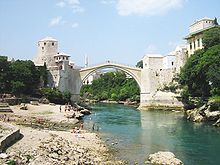Mimar Hayruddin (Hayruddin the architect; born c. 1500) was an Ottoman chief architect (Turkish: mimar) and civil engineer under the rule of Sultan Bayezid II (reigned 1481-1512/AH 886-918) and Sultan Suleiman the Magnificent (reigned 1520-1566).
Mimar Hayruddin | |
|---|---|
| Born | c. 1500 |
| Nationality | Ottoman |
| Occupation | Architect |
| Parent(s) | Ustad Murad, father, also an architect |
| Buildings | Stari Most Complex of Sultan Bayezid II Bayezid II Mosque |

A student of the celebrated Ottoman architect Mimar Sinan, Hayruddin was responsible for the construction of the Stari Most (Mostar Bridge) in the city of Mostar in Bosnia and Herzegovina,[1] the Bayezid II Mosque in Istanbul, the Külliye Complex of Sultan Bayezid II in Edirne, and another in town of Amasya.[2][3]
The Stari Most, in particular, is considered an exemplary piece of Balkan Islamic architecture.[4] Legend has it that Hayruddin was convinced his design would fail and, after nine years of construction, prepared himself to die on the day the bridge was finally unveiled.[5] Hayruddin's design was to endure until the destruction of the bridge by Croat forces in 1993.[6] The bridge was reconstructed, with work taking place from June 2001 until the new bridge was unveiled on 23 July 2004, at a cost estimated to be some 15.5 million US dollars.[7][8]
The Sultan Bayezid II complex is located on the banks of the Tunca River, consisting of a mosque, medical school, hospital and bathhouse, and in 2019 attracted some 7,000 tourists daily.[9]
Mimar Hayrüddin is considered to be one of the founders of the classical Ottoman style in architecture.[3]